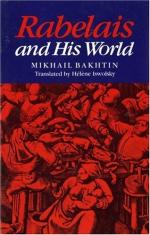
|
| Name: _________________________ | Period: ___________________ |
This quiz consists of 5 multiple choice and 5 short answer questions through Chapter 11, Chapter 3 - Popular - Festive Forms.
Multiple Choice Questions
1. How does Rabelais accomplish the grotesque degradation of his target in the prologue to the Third Book?
(a) By accusing the targets of paganism and crimes against the Church.
(b) By insulting the targets' mothers.
(c) By declaring the targets incapable of the basest bodily functions.
(d) By declaring the targets to be empty-headed.
2. What do oaths and curses have in common with town announcements and the calls of vendors?
(a) They all are forbidden during certain times of the year.
(b) They are all said with the same feelings in mind.
(c) They are the only socially acceptable methods of greeting strangers.
(d) They all are familiar parts of the society of the marketplace.
3. Rabelais' description of Alcibiades reflects:
(a) The image of Rabelais himself.
(b) The abuse/praise dynamics of the marketplace.
(c) The idea that ancient philosophies were incorrect.
(d) The good/evil dichotomy of mankind.
4. Why was gaming very important in the Renaissance?
(a) Games defined the distinction between social classes.
(b) Gaming reinforced the "official" ways of thinking.
(c) Games represented another form of understanding the cycle of life.
(d) Gaming was deemed sinful and was forbidden by the Church.
5. How, according to Bakhtin, does the current Russian literary criticism approach Rabelais' works?
(a) By trying to correctly interpret the source of the cultural laughter within them.
(b) By denouncing them as counterproductive to the ongoing Russian Revolution.
(c) By reviving their content in new, twentieth-century forms.
(d) By sharing them with an eager public.
Short Answer Questions
1. How does Bakhtin define the novel?
2. Bakhtin asserts that the advertisement for "pantagruelion" in the Third Book expresses:
3. In the Renaissance, bodily excretions were closely associated with:
4. Bakhtin asserts that the spirit of Carnival is essentially:
5. How did the French Romanticists respond to Rabelais' works?
|
This section contains 398 words (approx. 2 pages at 300 words per page) |

|




